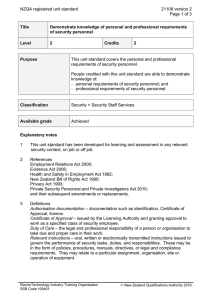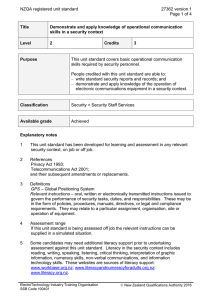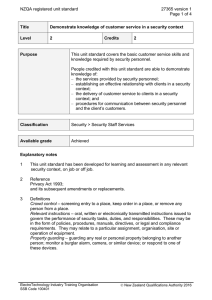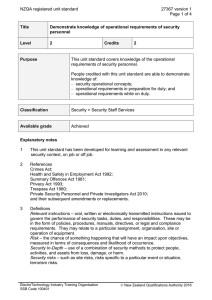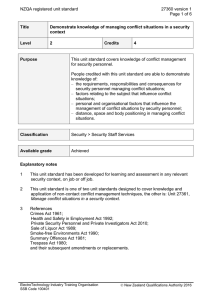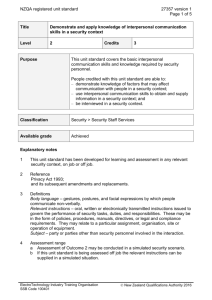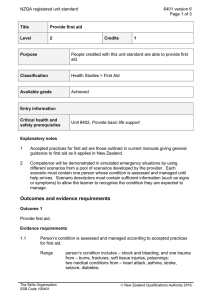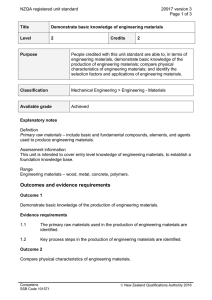NZQA registered unit standard 27361 version 1 Page 1 of 7
advertisement
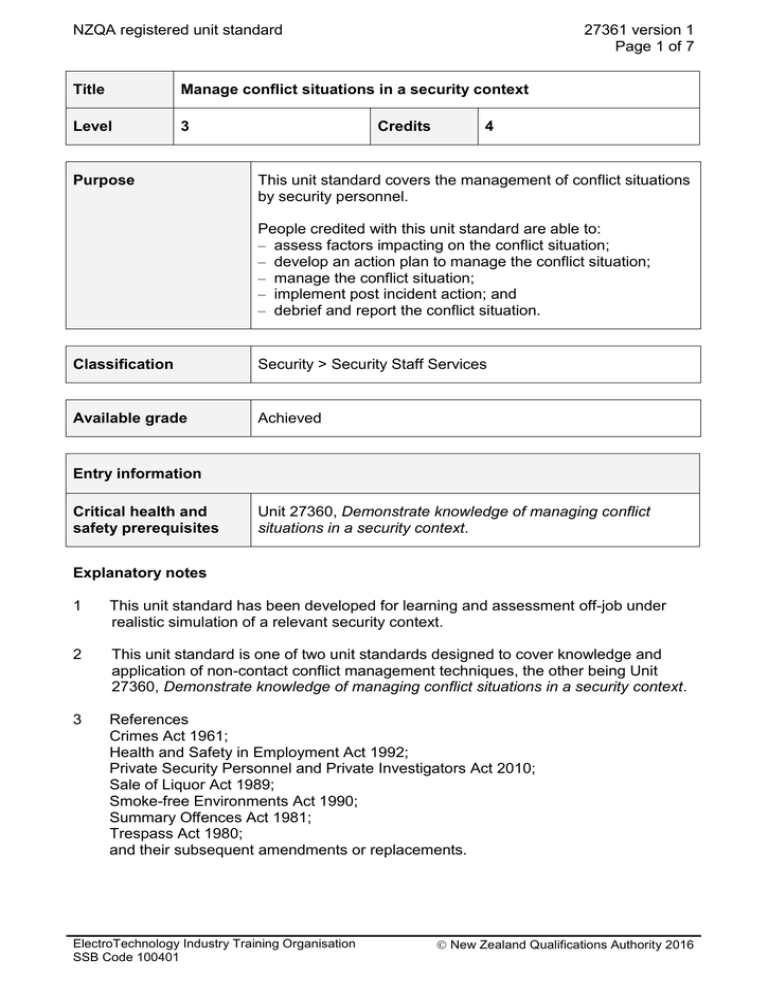
NZQA registered unit standard 27361 version 1 Page 1 of 7 Title Manage conflict situations in a security context Level 3 Purpose Credits 4 This unit standard covers the management of conflict situations by security personnel. People credited with this unit standard are able to: – assess factors impacting on the conflict situation; – develop an action plan to manage the conflict situation; – manage the conflict situation; – implement post incident action; and – debrief and report the conflict situation. Classification Security > Security Staff Services Available grade Achieved Entry information Critical health and safety prerequisites Unit 27360, Demonstrate knowledge of managing conflict situations in a security context. Explanatory notes 1 This unit standard has been developed for learning and assessment off-job under realistic simulation of a relevant security context. 2 This unit standard is one of two unit standards designed to cover knowledge and application of non-contact conflict management techniques, the other being Unit 27360, Demonstrate knowledge of managing conflict situations in a security context. 3 References Crimes Act 1961; Health and Safety in Employment Act 1992; Private Security Personnel and Private Investigators Act 2010; Sale of Liquor Act 1989; Smoke-free Environments Act 1990; Summary Offences Act 1981; Trespass Act 1980; and their subsequent amendments or replacements. ElectroTechnology Industry Training Organisation SSB Code 100401 New Zealand Qualifications Authority 2016 NZQA registered unit standard 27361 version 1 Page 2 of 7 4 Definitions Proportionate response – a response that is lawful, reasonable, justified, and appropriate in the situation. Relevant instructions – oral, written or electronically transmitted instructions issued to govern the performance of security tasks, duties, and responsibilities. These may be in the form of policies, procedures, manuals, directives, or legal and compliance requirements. They may relate to a particular assignment, organisation, site or operation of equipment. Subject – party or parties other than security personnel involved in the conflict. Situational awareness – timely recognition of factors that impact on objectives and provide a basis for making decisions. 5 Assessment range a It is recommended that assessment against this standard be undertaken in conjunction with Unit 27360, Demonstrate knowledge of the management of conflict situations in a security context; as the two standards assess complementary skills and knowledge. b Competence must be demonstrated in simulated conflict situations using face-toface role plays where candidates are given the opportunity to demonstrate their communication skills. Assessment scenarios are provided from a set of securityspecific scenarios which reflect common conflict situations encountered by security personnel. Candidates are required to demonstrate competence in each of the following types of situation: A Compliance situation – a situation that requires demonstration of positive communication skills when dealing with the public on day-to-day issues such as access control and identity checks. B De-escalation situation – a situation that requires demonstration of effective communication skills when calming an emotive situation, such as a situation involving an angry customer. C Assertive situation – a situation that requires non-aggressive but firm handling of unacceptable behaviour such as offensive language or a breach of conditions of entry. D Escalated situation – a situation where communication skills are used initially, followed by tactical withdrawal as the threat escalates. These four situations must be assessed across two or more scenarios. 6 Training and Assessment Requirements For the purposes of maintaining industry consistency the following conditions are included in ETITO's Consent and Moderation Requirements in relation to unit standards 27360 and 27361. a Training and assessment must only be delivered by trainers and assessors who have attended and successfully completed an ETITO recognised training and assessment course. b Trainers and assessors must attend and successfully complete an ETITO recognised refresher course every two years. c Assessors must use ETITO approved assessment resources. ETITO has developed and will make available training resources for this standard. 7 All actions taken must maximise safety and security of self and others, and must be carried out within the scope of own responsibility and authority. ElectroTechnology Industry Training Organisation SSB Code 100401 New Zealand Qualifications Authority 2016 NZQA registered unit standard 27361 version 1 Page 3 of 7 Outcomes and evidence requirements Outcome 1 Assess factors impacting on the conflict situation in a security context. Evidence requirements 1.1 Assess resources required to respond to the situation in terms of immediate availability and need to access. Range 1.2 Assess the subject's physical and any verbal indicators to determine their intent. Range 1.3 physical indicators may include but is not limited to – stance, gestures, facial expression; evidence of three physical indicators is required across the scenarios; verbal indicators may include but are not limited to – tone of voice, content of what is said, type of language used, silence; evidence of two verbal indicators is required across the scenarios. Assess environmental and subject factors, and their associated risks, to enhance situational awareness. Range 1.4 resources may include but are not limited to – support and assistance from other security personnel and/or emergency services; support and assistance from bystanders; communications equipment; protective equipment; alarm notification equipment such as duress buttons; distance; barriers; evidence of two resources is required across the scenarios. environmental factors may include but are not limited to – time of day, location (inside or outside building), site layout, presence of bystanders, presence and attitude of the subject's associates, exit options, traffic or moveable objects in vicinity; evidence of two environmental factors is required across the scenarios; subject factors may include but are not limited to – influence of drugs or alcohol, anger, stress, medical or psychological issues, evidence of weapons or potential weapons, size of subject, number of associates; evidence of two subject factors is required across the scenarios. Identify details of issues contributing to the conflict from observation and/or investigation. Range details of issues may include but are not limited to – what has happened, who is involved, identification of any associates of those involved, relationships between subject and associates; evidence of two details across the scenarios is required. ElectroTechnology Industry Training Organisation SSB Code 100401 New Zealand Qualifications Authority 2016 NZQA registered unit standard 1.5 27361 version 1 Page 4 of 7 Identify considerations en route to incident site in terms of maximising own safety. Range considerations may include but are not limited to – movement on foot, movement through buildings, movement by vehicle, ability to exit location, situational awareness, communication, obtaining and sending situational reports; evidence of two considerations across the scenarios is required. Outcome 2 Develop an action plan to manage the conflict situation in a security context. Evidence requirements 2.1 Identify own attributes in terms of the options available to respond to the situation. Range 2.2 Identify the intended outcome from the situation with regard to assessment of the situation and the responsibilities security personnel have in the situation. Range 2.3 intended outcome may include but is not limited to – subject becomes non-threatening, subject complies with requests, subject does not gain entry to premises, safety of subject and others is maintained until emergency services arrive. Consider options for action and plan intended action with regard to assessment of the situation, intended outcomes, proportionate response, and minimising risk. Range 2.4 own attributes may include but are not limited to – manner, personality, self confidence, ethnicity, gender, age, understanding of other languages and cultures, ability to speak other languages, interpersonal skills, physique, presentation; evidence of two attributes across the scenarios is required. options for action may include but are not limited to – allocation of responsibility, observation, request for support and assistance, notifying emergency services, evacuating uninvolved bystanders, isolation of subject, tactical withdrawal, defusing situation using communication techniques, working with a colleague to defuse situation using communication techniques; evidence of a minimum of two options is required for each security scenario. This must include a minimum of three different options across the scenarios. Identify alternative intended action for changing circumstances with regard to assessment of the situation, intended outcomes, proportionate response, and minimising risk. Outcome 3 ElectroTechnology Industry Training Organisation SSB Code 100401 New Zealand Qualifications Authority 2016 NZQA registered unit standard 27361 version 1 Page 5 of 7 Manage the conflict situation in a security context. Evidence requirements 3.1 Use distance, space, and body positioning to enhance own safety and allow options for dealing with the situation. Range 3.2 Use techniques and body language when approaching the subject to contribute to defusing the situation. Range 3.3 techniques may include but are not limited to – friendly and confident manner, building rapport, cultural considerations, tone of voice, language used; body language may include but is not limited to – stance, position of arms, eye contact, facial expression; evidence of two techniques and two examples of body language are required across the scenarios. Use communication skills and other techniques to de-escalate the situation. Range 3.4 distance, space and body positioning may include but are not limited to – positioning of self relative to subject and others, positioning of self and other security personnel relative to the subject and other persons present, anticipating and allowing distance between self and subject, giving subject an exit route, giving self an exit route; evidence of two is required across the scenarios. other techniques may include but are not limited to – empathy, enlisting support from the subject's associates or bystanders, maintaining subject's self esteem; evidence of one technique is required across the scenarios. communication skills may include but are not limited to – active listening, reflecting, rephrasing, summarising, questioning to clarify and confirm understanding, clear presentation of options and consequences, clear explanations and instructions, providing sufficient time for questions and responses; evidence of three communication skills is required across the scenarios. Identify, recall and record relevant information. Range relevant information may include – location, personal descriptions, speech and other distinguishing characteristics that aid identification and investigation, events, weapons and other items related to the subject, other information of use to police and other authorities; evidence of three pieces of relevant information across the scenarios is required. ElectroTechnology Industry Training Organisation SSB Code 100401 New Zealand Qualifications Authority 2016 NZQA registered unit standard 3.5 Communicate with other security personnel, operational management, and emergency services clearly and include relevant, accurate, and complete information. Range 3.6 27361 version 1 Page 6 of 7 communication may include but is not limited to – emergency alert, situation report to communications staff or supervisor, advising emergency services, briefing security personnel at the scene; evidence of two communications across the scenarios is required. information includes – location, details of subject and situation, assessment of the severity of the situation; information may include but is not limited to – intended actions, requirements of others, request for support and assistance, request for instructions, notification of withdrawal. Use tactical withdrawal if de-escalation techniques have not defused the situation, own safety is at risk, and if withdrawal is viable. Outcome 4 Implement post incident action in a security context. Evidence requirements 4.1 Check on the wellbeing of others involved in the incident and complete required follow-up action in accordance with relevant instructions. Range follow-up action may include but is not limited to – arranging treatment of any injuries, recording of any injuries and any treatment given, notifying communications staff and/or supervisor. 4.2 Protect any evidence or crime scenes from interference to preserve their integrity in accordance with relevant instructions as required. 4.3 Account for any equipment and keys and check them for damage. 4.4 Implement personal recovery strategies and procedures as required. Range personal recovery strategies may include but are not limited to – stress management, employee assistance programmes. Outcome 5 Debrief and report the conflict situation in a security context. Evidence requirements 5.1 Contribute to the debriefing process. Range contribution may include but is not limited to – how the situation happened, action taken, possible improvements to response in future, recommended actions; evidence of two contributions across the scenarios is required. ElectroTechnology Industry Training Organisation SSB Code 100401 New Zealand Qualifications Authority 2016 NZQA registered unit standard 5.2 Fulfil reporting requirements to ensure relevant information and any learning from the situation is transferred. reporting requirements include – notebook or logbook entry; and may include – incident report, hazard register, recommendations to management including any suggestions for changes to policy and procedure, request for equipment repairs. Range 5.3 27361 version 1 Page 7 of 7 Produce a clear, concise report in accordance with relevant instructions. Planned review date 31 December 2016 Status information and last date for assessment for superseded versions Process Version Date Last Date for Assessment Registration 1 20 October 2011 N/A Consent and Moderation Requirements (CMR) reference 0003 This CMR can be accessed at http://www.nzqa.govt.nz/framework/search/index.do. Please note Providers must be granted consent to assess against standards (accredited) by NZQA, before they can report credits from assessment against unit standards or deliver courses of study leading to that assessment. Industry Training Organisations must be granted consent to assess against standards by NZQA before they can register credits from assessment against unit standards. Providers and Industry Training Organisations, which have been granted consent and which are assessing against unit standards must engage with the moderation system that applies to those standards. Requirements for consent to assess and an outline of the moderation system that applies to this standard are outlined in the Consent and Moderation Requirements (CMR). The CMR also includes useful information about special requirements for organisations wishing to develop education and training programmes, such as minimum qualifications for tutors and assessors, and special resource requirements. Comments on this unit standard Please contact the ElectroTechnology Industry Training Organisation (ETITO) reviewcomments@etito.co.nz if you wish to suggest changes to the content of this unit standard. ElectroTechnology Industry Training Organisation SSB Code 100401 New Zealand Qualifications Authority 2016
